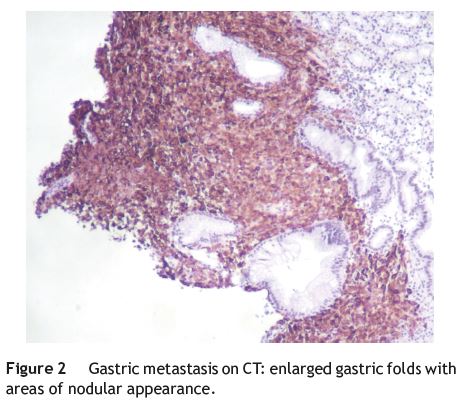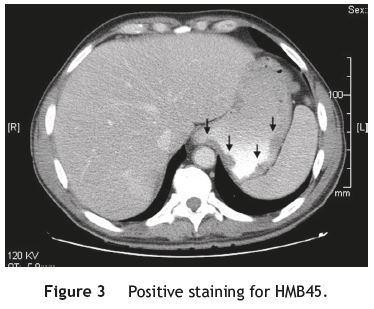Serviços Personalizados
Journal
Artigo
Indicadores
-
 Citado por SciELO
Citado por SciELO -
 Acessos
Acessos
Links relacionados
-
 Similares em
SciELO
Similares em
SciELO
Compartilhar
Jornal Português de Gastrenterologia
versão impressa ISSN 0872-8178
J Port Gastrenterol. vol.20 no.6 Lisboa dez. 2013
https://doi.org/10.1016/j.jpg.2013.07.002
ENDOSCOPIC SPOT
Multiple gastric metastases of malignant melanoma
Metastização gástrica múltipla de melanoma maligno
Manuela Canhotoa,∗, Sandra Barbeiroa, Bruno Arrojaa, Filipe Silvaa, Cláudia Gonçalvesa, Isabel Cotrima, Cristina Amadob, Maria Fernanda Cunhab, Martinha Henriquec, Helena Vasconcelosa
a Department of Gastroenterology, Centro Hospitalar Leiria-Pombal, E.P.E., Leiria, Portugal
b Department of Anatomopathology, Centro Hospitalar Leiria-Pombal, E.P.E., Leiria, Portugal
c Department of Dermatovenereology, Centro Hospitalar Leiria-Pombal, E.P.E., Leiria, Portugal
*Corresponding author
Introduction
Malignant melanoma that involves the gastrointestinal (GI) tract may be either primary or metastatic.1 Gastric metástases are rare and represent advanced disease.2 The incidence of metastases to the stomach is difficult to assess; however, the number of cases of gastric metastases from melanomas is significant. A series of necropsies in individuals with melanoma revealed gastric metastases rates of more than 22%.2
Symptoms, when present, are nonspecific and similar to those caused by other GI tumours: abdominal pain, dysphagia, altered bowel habits, tenesmus, small bowel obstruction or perforation, hematemesis, melena and anemia.3 Special immunohistochemical stains that include HMB-45 and S100 are important in confirming the diagnosis of metastatic melanoma.3 Management may include surgical resection, chemotherapy, immunotherapy, observation or engaging in clinical trials. Prognosis is poor, with a median survival of 6-9 months.4
Case report
A 54-year-old male patient presented to the emergency room with asthenia and a history of dark vomiting in the previous 24 h. He was pale with stable vital signs and haemoglobin of 8.6 g/dL (medium corpuscular volume 80.8 fl; medium corpuscular haemoglobin concentration 26.8 pg). He denied other gastrointestinal symptoms such as abdominal pain, previous vomiting and bleeding or altered bowel habits. Two weeks before, he had been submitted to surgical excision of a ulcerated dark nodular lesion of the left leg, with approximately 6 cm, diagnosed as malignant melanoma (Breslow depth >4mm; T4b),4 for which he first sought medical attention one week before due to local pain.
Upper endoscopy showed several nodular polypoid lesions, between 15 and 25mm with central ulceration and dark pigmentation (Fig. 1), along the proximal gastric body, with no major bleeding stigmata. The biopsy specimen confirmed metastatic malignant melanoma with immunohistochemistry stains positive for S-100 protein and HMB45 (Fig. 2).


A computer tomography (CT) revealed metastases to the liver, lungs, small bowel and the gastric metastasis (Fig. 3).

Although palliative surgery and chemotherapy were initially considered as therapeutic options, the multidisciplinar decision was to manage the patient, in stage IV disease and with fast clinical deterioration, with symptomatic therapy only, and he died two weeks later.
Discussion
In patients with a history of melanoma, a high index of suspicion for metastases needs to be present, and GI metastatic disease must be considered in the differential diagnosis of patients with acute anaemia and GI bleeding3 or nonspecific complaints, such as abdominal pain, weight loss or anorexia.1
Melanomas metastases are usually multiple ulcerated polypoid lesions, either pigmented or amelanotic, and may present at the time of diagnosis or years later.1
Surgical interventions for symptomatic patients with melanoma metastases of the GI tract may be considered for both palliation of symptoms and improvement in mortality.4 New therapeutic possibilities were recently developed, such as vemurafenib and ipilimumab, and while they still have limitations, they are the beginning of a new generation of therapies.5 Therapeutic decisions, especially in stage IV patients, should be managed by and interdisciplinary oncology team.4
References
1. Schuchter LM, Green R, Fraker D. Primary and metastatic diseases in malignant melanoma of the gastrointestinal tract. Curr Opin Oncol. 2000;12:181-5. [ Links ]
2. Campoli O, Ejima F, Cardoso D, Queiroz da Silva O, Santana Filho J, Barreto P, et al. Metastatic cancer to the stomach. Gastric Cancer. 2006;9:19-25. [ Links ]
3. Liang K, Sanderson S, Nowakowski G, Arora A. Metastatic malignant melanoma of the gastrointestinal tract. Mayo Clin Proc. 2006;81(4):511-6. [ Links ]
4. Garbe C, Peris K, Hauschild A, Saiag P, Middleton M, Spatz A, et al. Diagnosis and treatment of melanoma: European consensus-based interdisciplinary guideline - update 2012. Eur J Cancer. 2012;48(15):2375-90. [ Links ]
5. Finn L, Markovic SN, Joseph RW. Therapy for metastatic melanoma: the past, present and future. BMC Med. 2012;10:23. [ Links ]
Ethical disclosures
Protection of human and animal subjects. The authors declare that no experiments were performed on humans or animals for this study.
Confidentiality of data. The authors declare that they have followed the protocols of their work centre on the publication of patient data and that all the patients included in the study received sufficient information and gave their written informed consent to participate in the study.
Right to privacy and informed consent. The authors declare that no patient data appear in this article.
Conflicts of interest
The authors have no conflicts of interest to declare.
*Corresponding author
Correio eletrónico: manela_vc@yahoo.com (M. Canhoto).
Received 1 April 2013; accepted 31 July 2013













